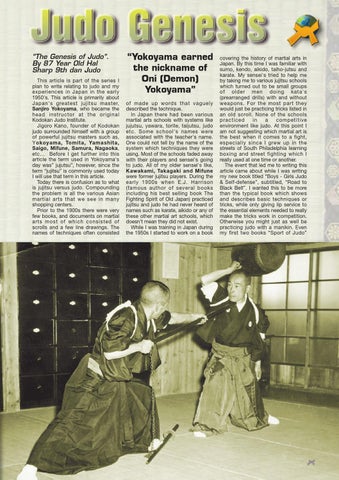“The Genesis of Judo”. By 87 Year Old Hal Sharp 9th dan Judo This article is part of the series I plan to write relating to judo and my experiences in Japan in the early 1950's. This article is primarily about Japan's greatest jujitsu master, Sanjiro Yokoyama, who became the head instructor at the original Kodokan Judo Institute. Jigoro Kano, founder of Kodokan judo surrounded himself with a group of powerful jujitsu masters such as, Yokoyama, Tomita, Yamashita, Saigo, Mifune, Samura, Nagaoka, etc… Before I get further into this article the term used in Yokoyama's day was” jujutsu”, however, since the term “jujitsu” is commonly used today I will use that term in this article. Today there is confusion as to what is jujitsu versus judo. Compounding the problem is all the various Asian martial arts that we see in many shopping centers. Prior to the 1900s there were very few books, and documents on martial arts most of which consisted of scrolls and a few line drawings. The names of techniques often consisted
“Yokoyama earned the nickname of Oni (Demon) Yokoyama” of made up words that vaguely described the technique. In Japan there had been various martial arts schools with systems like jujutsu, yawara, torite, taijutsu, judo etc. Some school's names were associated with the teacher's name. One could not tell by the name of the system which techniques they were using. Most of the schools faded away with their players and sensei's going to judo. All of my older sensei's like, Kawakami, Takagaki and Mifune were former jujitsu players. During the early 1900s when E.J. Harrison (famous author of several books including his best selling book The Fighting Spirit of Old Japan) practiced jujitsu and judo he had never heard of names such as karate, aikido or any of these other martial art schools, which doesn't mean they did not exist. While I was training in Japan during the 1950s I started to work on a book
covering the history of martial arts in Japan. By this time I was familiar with sumo, kendo, aikido, taiho-jutsu and karate. My sensei's tried to help me by taking me to various jujitsu schools which turned out to be small groups of older men doing kata's (prearranged drills) with and without weapons. For the most part they would just be practicing tricks listed in an old scroll. None of the schools practiced in a competitive environment like judo. At this point I am not suggesting which martial art is the best when it comes to a fight, especially since I grew up in the streets of South Philadelphia learning boxing and street fighting which I really used at one time or another. The event that led me to writing this article came about while I was writing my new book titled “Boys - Girls Judo & Self-defense”, subtitled, “Road to Black Belt”. I wanted this to be more than the typical book which shows and describes basic techniques or tricks, while only giving lip service to the essential elements needed to really make the tricks work in competition. Otherwise you might just as well be practicing judo with a manikin. Even my first two books “Sport of Judo”
